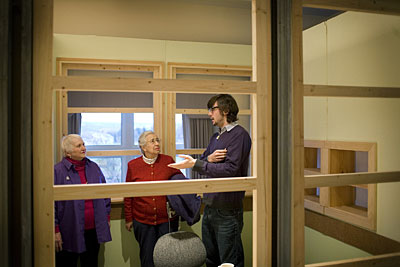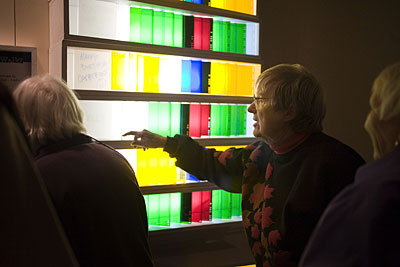Students design exercise and physical therapy spaces for Kendal residents
By Sheri Hall

The challenge put to a group of Cornell students: Make exercise more convenient, safer and more enjoyable for residents of Kendal at Ithaca, a retirement community. The result: Full-scale models that include a system to help the elderly monitor their exercise and a physical therapy exam room to give the residents more privacy.
Cornell interior design and behavioral science students worked in a collaborative project across two courses this semester, spending time at Kendal conducting research and interviewing Kendal staff and residents. Then they designed new fitness and physical therapy spaces and built full-scale models of their proposed solutions.
Their proposals, which were presented Dec. 4 to the residents of Kendal at Ithaca, included:
The projects were based on collaborations between two classes: professor Paul Eshelman's Intermediate Interior Design and professor Gary Evans' Environmental and Social Behavior, both in Cornell's College of Human Ecology. The students in Evans' class served as behavioral science consultants, researching the needs of senior housing facility residents and developing design guidelines. Eshelman's class created the designs.

"The crucial component is that it's a real-life challenge," Evans said. "It's a great way to teach because the students are so motivated to solve a real problem."
The projects also involved learning about building materials, hardware, tool use, structural integrity and model construction, which included ordering materials, planning tasks that involved students from both classes, building in the workshop and planning for their presentations.
Students teamed up from the beginning with Kendal residents, visiting the physical therapy rooms and taking walks around the Kendal campus.
"The students put a lot of thought and effort into this," said Tom Scott, a Kendal resident who uses the community's exercise facilities each morning. "We have some real needs to improve these areas, so it was wonderful to have their input."
For junior Abbey Kesten, the fun part of the project was incorporating input from residents like Scott. "It was fun because they were excited about our project," she said. "And it was interesting to see their reactions to our proposal."
This is the second year the classes have collaborated to design new spaces at Kendal. Last year, they created designs for the cafeteria and the dining areas.
The project was supported by Kendal at Ithaca, the 2008 Kaplan Family Distinguished Faculty Fellowship in Service-Learning, Living Environments Aging Partnership and Cornell's College of Human Ecology.
Sheri Hall is assistant communications director for the College of Human Ecology.
Media Contact
Get Cornell news delivered right to your inbox.
Subscribe